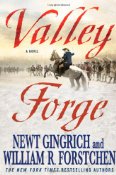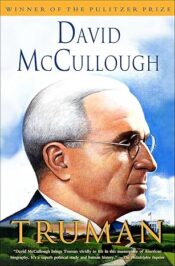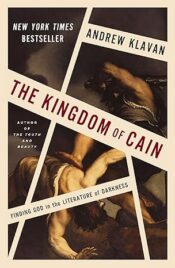
Valley Forge by Newt Gingrich and William R. Forstchen
 Valley Forge has all the attributes of an engaging novel: A good plot, a strong protagonist (George Washington), and believable villains. In addition, Valley Forge is an historical novel, so it must accurately portray real events and the people engaged in them.
Valley Forge has all the attributes of an engaging novel: A good plot, a strong protagonist (George Washington), and believable villains. In addition, Valley Forge is an historical novel, so it must accurately portray real events and the people engaged in them.
Gingrich and Forstchen do it all, and they do it well. The research rings true, and if the writing becomes polemical from time to time, it is forgivable. This book would make an excellent addition to a high school reading list. It could stimulate interest in an important period of American history often unimaginatively written and made dull in textbooks. That having been said, it is also true that some prior knowledge of the characters and events make reading Valley Forge even more enjoyable.
It’s a little like attending a reunion. There’s General Charles Lee, self-serving, a braggart, and a coward, described in Edwin G. Burrows book, Forgotten Patriots, as behaving shamefully while a prisoner of the British. In Valley Forge, Lee’s disregard of Washington’s orders at the Battle of Monmouth confirms everything Burrows and others have written about Lee. The reader enjoys a pleasurable sense of justice done when Washington removes Lee from command and drums him out of the Continental Army in disgrace.
General Horatio Lloyd Gates, briefly encountered in the letters between John and Abigail Adams (First Family by Joseph Ellis), and elsewhere as the self-proclaimed hero of the Battle of Saratoga, makes his debut in Philadelphia. While Washington struggles to keep the Army from starving and freezing to death at Valley Forge, Gates tries to persuade Congress to replace Washington and make himself Commander-in-chief.
Other historical figures in the book include Martha Washington; the Marquis de Lafayette; Molly Pitcher (last encountered loading canon in The American Revolution, a Concise History by Robert Allison); General (Mad) Anthony Wayne, survivor of Paoli where, (according to Burrow’s account), British troops butchered surrendering rebels instead of taking them prisoner; and General Henry Clinton, (described by Tuchman in The First Salute as somewhat beyond his prime when sent by Parliament to replace General Howe).
Baron Friedrich von Steuben (from The Drillmaster of Valley Forge) appears late in the novel, as he does in the War, to teach the Continental Army the discipline and drills needed to stand against the well-trained British Army. The authors of Valley Forge go beyond the image of the stereotypical Prussian officer by endowing Steuben with humor and humanity.
Members of the Second Continental Congress do not fare as well. George Washington was exasperated with Congress for failing to provision the army at Valley Forge as promised. Congress, of course, had significant problems of its own. However, given the less than flattering portrayal of congressional dithering and indecisiveness, it is tempting to conclude that, as a group, politicians haven’t changed much in 200 years.
The fictional characters move the story along. The narrative alternates between Pvt. Peter Wellsley, a young patriot at Valley Forge who almost died of cold and sickness, and Allen Van Dorn, a neighbor of Wellsley who joined the Loyalist cause. The sympathetic depiction of the two young men reveals that the divisions within families and between neighbors in the Revolutionary War were every bit as wrenching as those experienced 100 years later in the American Civil War. The contrast between the opulence of Philadelphia where Van Dorn is stationed and the privation suffered by Wellsley at Valley Forge is stark. The horrific conditions at Valley Forge are conveyed with a reality missing in most historians’ accounts.
Having suffered the freezing cold and storms of the harsh New England winter in 1777, the Continental Army endures unusually high summer temperatures in 1778 as Washington orders his men to harasses the British as they march back to New York City. The British, wearing heavy woolen jackets (which they are forbidden to remove) and carrying 80 pound packs, also suffer greatly from the broiling sun, and the roads become lined with dead and dying heat stroke victims from both armies.
Washington’s final victory at the Battle of Monmouth redeems his reputation and marks the beginning of the end of the War. In addition, it stops the machinations of Gates and his confederates. As the authors write in a note at the end of the book:
“It is easy today to assume that our heroic image and memory of General Washington stood as solid as it does now. That belief is to ignore the reality of history throughout the ages…the conspiracy to destroy his (Washington’s) reputation and have him removed from command was indeed real.â€
Pauline Maier in Ratification points out the closeness of the votes at the state ratification conventions and that it was a near thing when the Constitution was approved. In Valley Forge, we learn that the War might easily have gone the other way.
Had Howe pursued the fleeing Continental Army in 1776 after British victories in the battles of Long island, White Plains and Fort Washington, there is every reason to believe the war would have ended quickly with a British victory.
Similarly, instead of wintering in Philadelphia enjoying the hospitality and largess of Loyalist hosts, had Howe sent a force against Washington when conditions at Valley Forge were at their worst, the dispirited and starving troops quartered there could have been killed or captured, perhaps Washington among them.
Had London not ordered General Henry Clinton, Howe’s replacement, to pull back to New York, the out-of-condition British Army would not have been strung out for miles in the heat and subjected to Washington’s newly battle-ready troops.
Finally, had Gates and his confederates in Philadelphia succeeded in their plot against Washington, we might now be British subjects!
Historian David McCullough in his book 1776 chronicles the events of that one fateful year of the Revolutionary War. At the end of that book McCullough seemed to infer that Providence played a part in the survival of Washington’s Army. In Valley Forge, the reader is drawn to a similar conclusion.
Valley Forge is the first Gingrich and Forstchen book this reviewer has read. It won’t be the last.
 The posts are coming!
The posts are coming!


3 comments
Enjoyed this post, sir. And felt even more at home now that Hayek (or was it Mises, either way) has left the margins. I’ll now be back for much more! As Jefferson would have suggested when he warned against releasing powers to individuals “the exercise of which they are [not] competentâ€, laissez-faire has no place in the American system. Cheers!
[Reply]
Thanks Christopher, Jefferson is not one of our favorite founders here at WWTFT, but even so, to be preferred over any most any modern politico I can think of. The book was good and we’ve just received its predecessor.
[Reply]
Thanks for the review. I’ll add this one to my ‘to read’ list, which grows longer by the day.
[Reply]
Leave a Comment